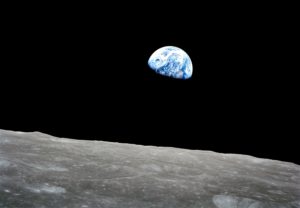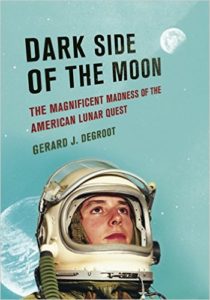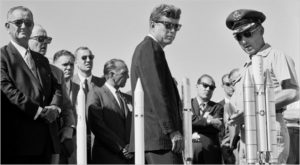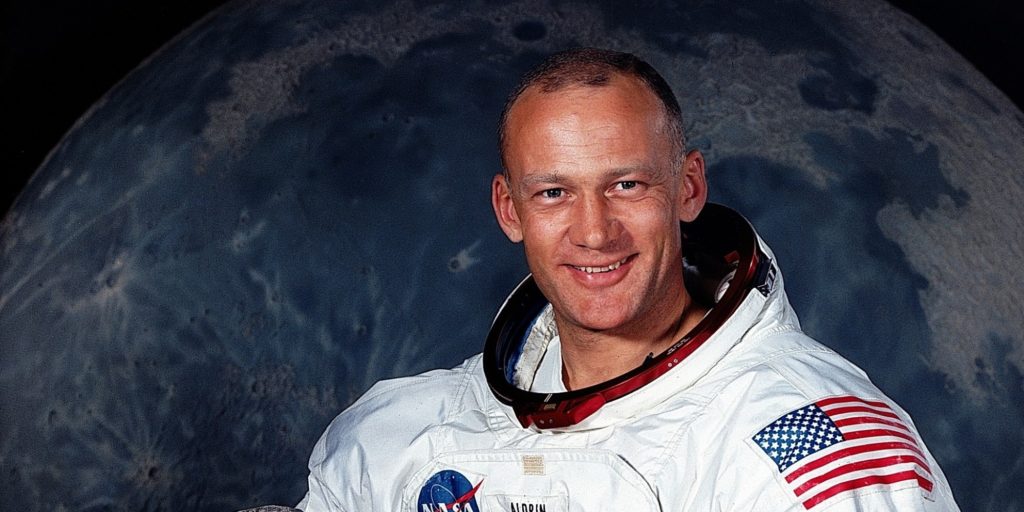The Final Frontier
Appeared in the Tampa Bay Times, 2006

Of all the devalued words in our language, “incredible” is at the top of the list. People talk about video games or sneakers as “incredible.” So what word can we invent to describe the landing on the moon?
Because that was incredible. Here’s a few more words to describe it: “improbable,” “insane” and “magnificent.”
Maybe you think you know the story of the race to the moon because you read Tom Wolfe’s The Right Stuff. That was a terrific book that wove something epic out of tapestry of silliness, ego and blind ambition.

But Wolfe’s book was tightly focused on the astronauts. Gerard DeGroot’s wonderful new book, Dark Side of the Moon, looks at all aspects of the space program and gives us a complete picture of the glorious folly that was the race to the moon.
DeGroot, a historian at Scotland’s University of St. Andrews, has written a witty and elegant book about America’s desperate gamble for space supremacy.
Exploring space was the next step in the nation’s manifest destiny and the fulfillment of the Turner Thesis – that America was a nation dependent on the concept of the frontier for its growth and development. Space was a natural outlet for the pent-up American spirit. Captain Kirk was right; it really was the Final Frontier
But why? We knew the moon was a hunk of rock before we got there. Did visiting it teach us anything we didn’t already know?
Spending the billions to get us to the moon was a political, not a scientific decision. President Kennedy needed something to show that America was superior to the Soviet Union. When the Russians beat us into space in 1957 with the Sputnik satellite, America started out behind.

With clever marketing and public relations, the Americans soon caught up and offered up seven handsome heroes, the original seven Mercury astronauts. The Magnificent Seven and their beautiful wives were sold to America through the glossy color pages of LIFE magazine, but the public façade stopped when the astronauts returned to training in Cocoa Beach, where their groupies lined up three or four women deep outside their motel rooms.
With Kennedy looking for something to rally the nation behind after his disastrous effort to invade Cuba, he suggested that we try to land men on the moon by the end of the decade. Seemed like a good idea at the time. JFK realized that the money would be better spent at home, but the nation’s prestige was on the line.
Politicians and defense contractors lined up butt-to-bellybutton to dine at the government trough, courtesy of the new space agency, NASA. The general feeling on Capitol Hill was that any senator who did not use his position to make money was a sucker. Billions were appropriated and the largesse was spread around – to Florida, to Huntsville, Ala., and to Houston, where towns populated by NASA families took over. As the space program took hold, Brevard County in Florida grew from 23,000 people to 239,000. One Brevard neighborhood, Lunar Heights, was a series of streets in concentric rings, just like the solar system. The nation was space-crazy.

Despite the connection between JFK and the space program in the public mind, the president wasn’t entirely jazzed about it. To him, NASA was like Kudzu, the vine that grows and suffocates all that it comes into contact with. DeGroot characterizes the space race as being something of an ogre to the president. At one point, he considered partnering with the Soviets, which would have derailed the whole reason for the race to the moon – competition.
Kennedy’s assassination assured that the space race would continue. His successor, Lyndon Johnson, knew that America loved All Things Jack and if JFK said we’d be on the moon by decade’s end, then LBJ would make sure it happened.
The astronauts were the heroes, of course, and DeGroot details every mission. Each one seemed to have some kind of screw-up, but somehow America lucked out until the disaster on the Apollo 1 launching pad that killed three astronauts. That was in early 1967, but rather than slow down, Johnson pushed to meet Kennedy’s end-of-the-decade deadline.

Amazingly, we made it. When Neil Armstrong stepped out on the moon and did his one-small-step-for-man thing, it was a monument-ready statement. What Buzz Aldrin said when he came down the ladder after Armstrong was more telling. He looked around the bleak surface of the moon and said, “Magnificent desolation.” Looking back on earth in all of its lush beauty, he wondered why we would ever want to leave it.
Perhaps we did it to see if we could. We could. As physicist J. Robert Oppenheimer said, “Scientific discovery is made not because it is useful but because it is possible.” When something went wrong – as it did with Apollo 13 – we were even able to overcome disaster and return the astronauts to earth from certain death.
But who cared? After the first moon landing, the public lost interest. Networks were besieged with angry phone callers when they cut into programming of coverage of a launch. “When a rose reaches its peak of beauty,” DeGroot writes, “it is already in a state of decay.” An enormous so-what followed the moon landing. Too bad. No matter how cynical we might be about the motivation behind the space race, DeGroot makes us appreciate the splendor of the achievement.
